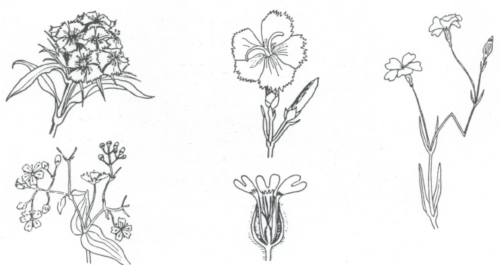Family Description
The Pinks family is a widely distributed group of north temperate dicotyledonous annual and perennial herbs with conspicuously swollen nodes. Leaves are opposite, simple, entire (often lanceolate) and with parallel venation. Flowers are showy, usually with perfect symmetry and borne singly or in cymes or panicles. Flowers are 5-merous with the calyx cup-like and holding the free petals as if they formed a short tube. Flowers are often white, but other bright colors (excluding blues) are common. The fruit is a dry capsule which opens at the apex but remains erect. Seeds are numerous and readily pour from the capsule when ripe.
-
Main diagnostic features include:
- opposite, lanceolate, often waxy leaves
- the swollen nodes
- characteristic capsule which opens by terminal pores
The Caryophyllaceae family as a group do best in full sun with neutral (sometimes alkaline) soils which have excellent drainage. Propagation is by cuttings or seeds. Seeds germinate readily with temperatures above 65°F. Pests are not common but poor drainage or hot conditions can result in root rot problems.
This important garden family includes: Agrostemma, Arenaria, Cerastium, Dianthus, Drypis, Gypsophila, Herniaria, Lychnis, Paronychia, Petrocoptis, Petrohagia, Sagina, Saponaria, Silene, Stellaria, Telephium and Vaccaria.

Dianthus barbatus (upper left), Gypsophila repens (lower left), Dianthus deltoides (top center), a typical flower (lower center) -- Note terminal notch, Silene sp. (right).
Representative Species
| * | Dianthus barbatus | Sweet William |
|
||||
| * | Dianthus caryophyllus | Carnation | |
||||
| * | Dianthus chinensis |
Annual Pink |
|
||||
| Dianthus chinensis x barbatus |
Hybrid Pink |
|
|||||
| * | Gypsophila elegans | Baby’s Breath |
|

